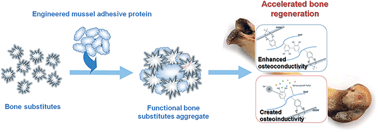Engineered mussel bioglue as a functional osteoinductive binder for grafting of bone substitute particles to accelerate in vivo bone regeneration
Abstract
Xenograft bone substitutes, such as deproteinized bovine bone mineral (DBBM), have been widely employed as osteoconductive structural materials for bone tissue engineering. However, the loss of xenograft bone substitute particles in defects has been a major limitation, along with a lack of osteoinductive function. Mussel adhesive protein (MAP), a remarkable and powerful adhesive biomaterial in nature, can attach to various substrates, even in wet environments. Its adhesive and water-resistant abilities are considered to be mainly derived from the reduced catechol form, 3,4-dihydroxyphenylalanine (DOPA), of its tyrosine residues. Here, we evaluated the use of DOPA-containing MAP as a functional binder biomaterial to effectively retain DBBM particles at the defect site during in vivo bone regeneration. We observed that DOPA-containing MAP was able to bind DBBM particles easily to make an aggregate, and grafted DBBM particles were not lost in a defect in the rat calvaria during the healing period. Importantly, grafting of a DOPA-containing MAP-bound DBBM aggregate resulted in remarkably accelerated in vivo bone regeneration and even bone remodeling. Interestingly, we found that the DOPA residues in the modified MAP had an osteoinductive ability based on clear observation of the in vivo maturation of new bones with a similar bone density to the normal bone and of the in vitro osteogenic differentiation of osteoblast cells. Collectively, DOPA-containing MAP is a promising functional binder biomaterial for xenograft bone substitute-assisted bone regeneration with enhanced osteoconductivity and acquired osteoinductivity. This mussel glue could also be successfully utilized as a potential biomaterial for general bone tissue engineering.


 Please wait while we load your content...
Please wait while we load your content...